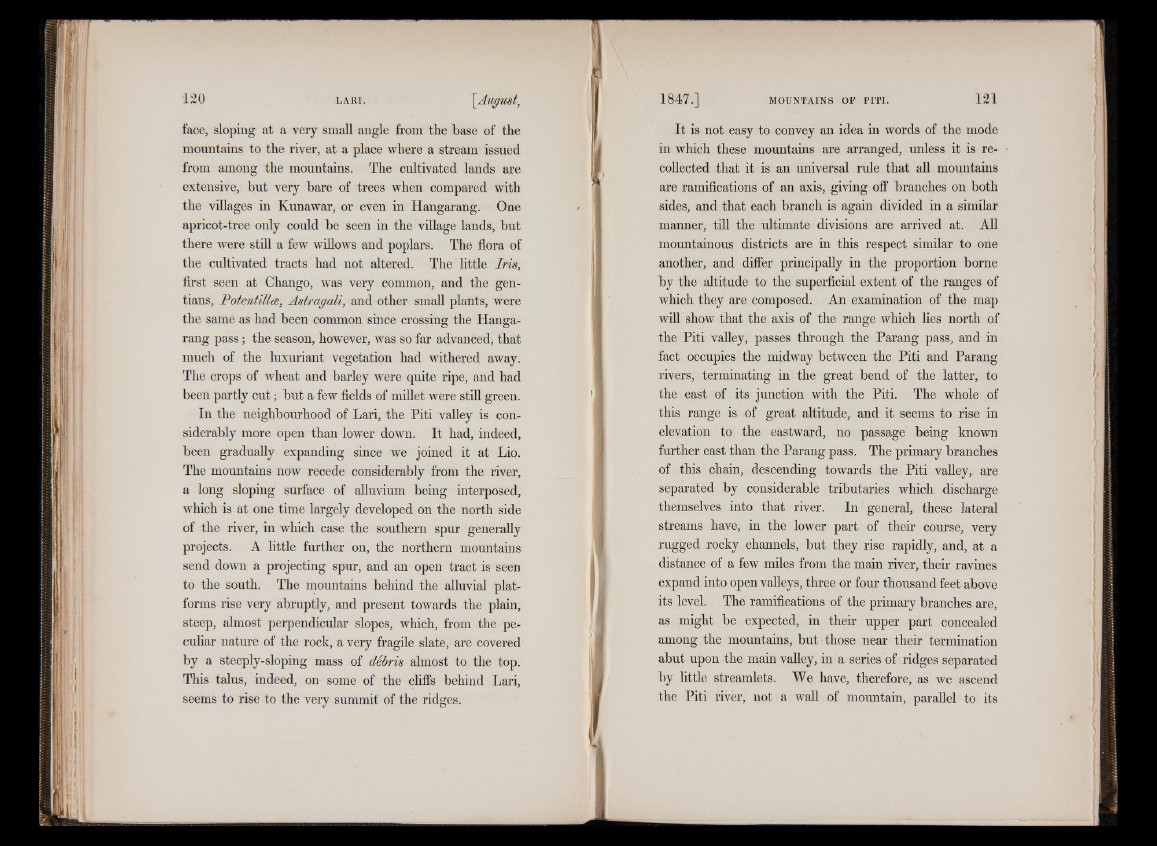
face, sloping at a very small angle from the base of the
mountains to the river, at a place where a stream issued
from among the mountains. The cultivated lands are
extensive, but very bare of trees when compared with
the villages in Kunawar, or even in Hangarang. One
apricot-tree only could be seen in the village lands, but
there were still a few willows and poplars. The flora of
the cultivated tracts had not altered. The little Iris,
first seen at Chango, was very common, and the gentians,
Potentittce, Astragali, and other small plants, were
the same as had been common since crossing the Hangarang
pass; the season, however, was so far advanced, that
much of the luxuriant vegetation had withered away.
The crops of wheat and barley were quite ripe, and had
been partly cut; but a few fields of millet were still green.
In the neighbourhood of Lari, the Piti valley is considerably
more open than lower down. It had, indeed,
been gradually expanding since we joined it at Lio.
The mountains now recede considerably from the river,
a long sloping surface of alluvium being interposed,
which is at one time largely developed on the north side
of the river, in which case the southern spur generally
projects. A little further on, the northern mountains
send down a projecting spur, and an open tract is seen
to the south. The mountains behind the alluvial platforms
rise very abruptly, and present towards the plain,
steep, almost perpendicular slopes, which, from the peculiar
nature of the rock, a very fragile slate, are covered
by a steeply-sloping mass of debris almost to the top.
This talus, indeed, on some of the cliffs behind Lari,
seems to rise to the very summit of the ridges.
It is not easy to convey an idea in words of the mode
in which these mountains are arranged, unless it is recollected
that it is an universal rule that all mountains
are ramifications of an axis, giving off branches on both
sides, and that each branch is again divided in a similar
manner, till the ultimate divisions are arrived at. All
mountainous districts are in this respect similar to one
another, and differ principally in the proportion borne
by the altitude to the superficial extent of the ranges of
which they are composed. An examination of the map
will show that the axis of the range which lies north of
the Piti valley, passes through the Parang pass, and in
fact occupies the midway between the Piti and Parang
rivers, terminating in the great bend of the latter, to
the east of its junction with the Piti. The whole of
this range is of great altitude, and it seems to rise in
elevation to the eastward, no passage being known
further east than the Parang pass. The primary branches
of this chain, descending towards the Piti valley, are
separated by considerable tributaries which discharge
themselves into that river. In general, these lateral
streams have, in the lower part of their course, very
rugged rocky channels, but they rise rapidly, and, at a
distance of a few miles from the main river, their ravines
expand into open valleys, three or four thousand feet above
its level. The ramifications of the primary branches are,
as might be expected, in their upper part concealed
among the mountains, but those near their termination
abut upon the main valley, in a series of ridges separated
by little streamlets. We have, therefore, as we ascend
the Piti river, not a wall of mountain, parallel to its